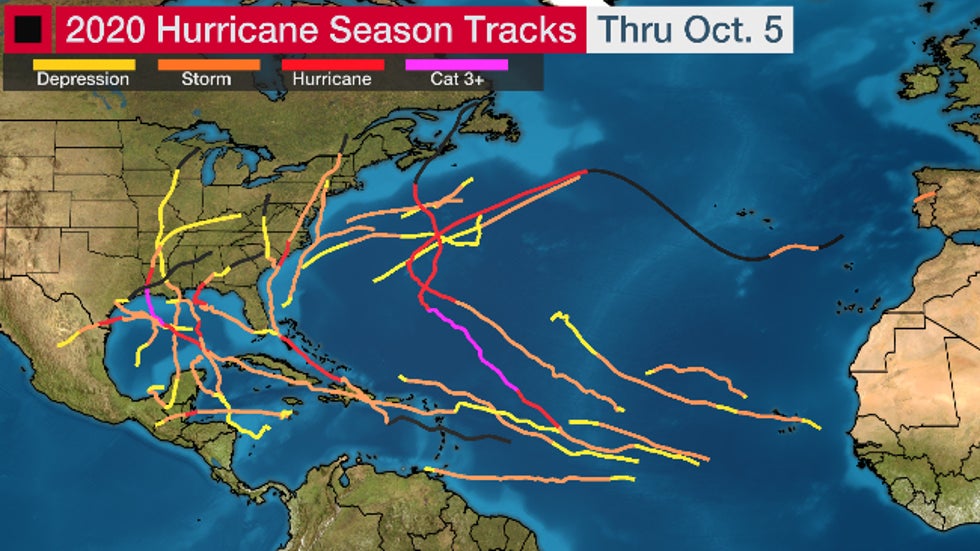Jonathan Erdman
The 2020 Atlantic hurricane season is nearing an all-time record for the number of storms, boosted by two recent Caribbean and Gulf of Mexico storms.
With the formation of Tropical Storm Gamma and now Hurricane Delta, we've seen 25 named storms so far this season.
Only the 2005 season – with 27 named storms and one unnamed storm – remains above 2020 on the list of seasons with the most storms.
2020 may be three storms behind 2005's total, but it's on a record pace. Through Oct. 5, the 2005 hurricane season generated 20 storms – five fewer than 2020, so far.
The 25th storm of the record 2005 season didn't develop until Nov. 15, over five weeks later in the season than 2020's 25th storm, Delta, according to Colorado State University tropical scientist Phil Klotzbach.
The 2020 hurricane season exhausted its entire list of names on Sept. 18, having to use the Greek alphabet for subsequent names for only the second time – the first being 2005.
We're already four deep into the Greek alphabet. The deepest 2005 went into the Greek alphabet was Zeta, only two names away in 2020 (one unnamed storm was added after post-season analysis of the 2005 season, accounting for 2005 only going through Zeta, instead of Eta, in the names list).
(MORE: What Happens If a Hurricane With a Greek Alphabet Name Has to Be Retired?)
 Greek alphabet names used (crossed out in red) after the 21 names of the 2020 Atlantic hurricane season were already used up before the end of September.
Greek alphabet names used (crossed out in red) after the 21 names of the 2020 Atlantic hurricane season were already used up before the end of September.Contrasting this storm tally with an average season is even more stunning.
By early October, the average storm count is usually between nine and 10, according to statistics compiled by Klotzbach.
After adjusting for past hurricane seasons to account for lower detection of storms, the average storm count for a full season is 13.
So we've had roughly two full average seasons' worth of storms in 2020, so far. And the season isn't over yet.
 Number of storms so far in the 2020 Atlantic hurricane season, compared to an average full season (middle bar) and the record 2005 season.
Number of storms so far in the 2020 Atlantic hurricane season, compared to an average full season (middle bar) and the record 2005 season.How Many More?
If the rest of the season is just average, we would expect another three to four storms. That would take the season's tally to 28 or 29 storms, equaling or topping the 2005 record and taking us through Eta or Theta in the Greek alphabet.
One year ago on Oct. 5, we had just finished up with Category 5 Hurricane Lorenzo, only the 12th storm of that season.
Another six storms formed after Oct. 5 last season. If that happens this season, that would take us through Kappa in the names list, an incredible 31 storms in one season.
What if the rest of the season mirrors 2005?
The 2005 season produced another eight storms after Oct. 5, not ending until Jan. 6, 2006. That would use up half the Greek alphabet, ending with Mu.
 2020 Atlantic hurricane season tracks to-date through Oct. 5.
2020 Atlantic hurricane season tracks to-date through Oct. 5.There are various other ways to measure the magnitude of a hurricane season.
For example, Delta has become the ninth hurricane of the season, but nowhere near the record of 15 hurricanes in 2005. There are a number of seasons dating to 1851 that have produced 10 or more hurricanes.
Having said that, Klotzbach noted only three other seasons had as many or more than nine hurricanes this "early" in the season - 1995, 2004 and 2005.
By another metric called the ACE index – short for Accumulated Cyclone Energy – which takes into account not just the number, but also the intensity and longevity of storms and hurricanes, 2020 is above average, but well shy of record seasons such as 1893, 1933 and 2005, according to Klotzbach's statistics.
The reason for this: the overwhelming number of shorter-lived storms in 2020. So far, hurricanes Paulette and Teddy were the only two that lasted longer than a week as named storms.
The Weather Company’s primary journalistic mission is to report on breaking weather news, the environment and the importance of science to our lives. This story does not necessarily represent the position of our parent company, IBM.
The Weather Company’s primary journalistic mission is to report on breaking weather news, the environment and the importance of science to our lives. This story does not necessarily represent the position of our parent company, IBM.

No comments:
Post a Comment